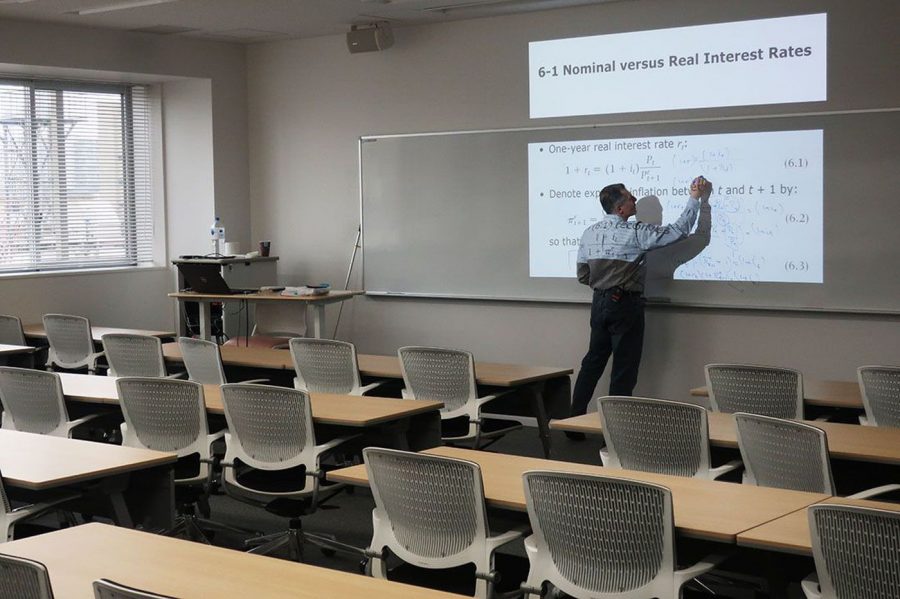Photo Courtesy of inquirer.com
Empty college classrooms like these are found throughout the country as professors have to switch to virtual learning to minimize the spread of COVID-19.
College Tuition Fees Face Backlash
Throughout the nation, college costs remain high despite the change to online classes.
As COVID-19 spread through the United States in early March, colleges were forced to clear their campuses of students and divert them to online classes for distanced learning. At the time, the virus was new, quarantine was taken seriously and tuition fees for the school year had already been paid. Few people expected for social distancing policies to affect the fall 2020 semester. Now, as colleges are going fully virtual and small colleges are pursuing a hybrid model, Americans are questioning whether high tuition costs should be lowered, claiming that the experience and format of online learning are of lower quality than face to face interactions with professors.
Many argue that the high tuition costs are no longer worth it without the “college experience” of campus life, face to face classes and networking. People value in-person learning much more than online learning because education is seen as an experience and an understanding with the professor rather than a Zoom call. Petitions have been signed demanding tuition fee cuts at thousands of colleges across the nation, and those who were accepted at high-level universities are choosing not to attend because their school is implementing online classes. According to nytimes.com, roughly one fifth of Harvard’s freshman class deferred admission after Harvard announced that it would go fully virtual for the 2020-2021 school year. Harvard is maintaining the same tuition fees as a normal year, averaging at around $50,000 (after financial aid) for each year per student despite their 40.9 billion dollar endowment fund. Some have even tried to take legal action, charging universities with breach of contract for switching face to face classes with online classes. College tuition costs have been debated and criticized in the past because of alumni’s piling student debt that often follows them for the next few decades of their lives disabling them from making important adult purchases and decisions. But with the recent switch to virtual learning, seeing higher education as “overpriced” has become more widespread. The question college students are faced with now is whether being able to say they went to a prestigious, expensive college is worth the student debt that will follow them for years to come when they only get to learn sitting at home on a Zoom call.
Tuition controversy sparked at NYU’s Tisch School of the Arts this spring when angry undergraduates contacted the administration demanding tuition cuts from the average $58,550 cost per year because they found Zoom classes inefficient for learning art skills. The dean replied with an email failing to address their demands and an attached video of her dancing to “inspire” the students through this uncertain time. The video was found tone-deaf and NYU faced backlash from the media and their alumni.
One angry alumnus, accomplished SNL writer Anna Drezen, tweeted out about her anger towards NYU’s response and embarrassment as a former acting student.
“It’s already borderline immoral to take $80,000 a year from people in exchange for the promise of a career in pretending, but it’s very immoral when those pretending classes don’t even happen in person,” Drezen said.
While it is easy to become infuriated at the higher education system after feeling cheated of an education, it is important to take into consideration the economic hardships that colleges have had to face with the virus as well. Due to social distancing protocols, colleges missed major revenue from spring events, especially sporting events. Large colleges who depend on their football season or basketball season will also have to cancel sports for the fall season as COVID-19 continues. There are also significant costs in sanitation measures that college campuses must take, such as purchasing masks, extra cleaning equipment, thermometers, etc. The highest expenses, which often cost millions for large schools, is the investment in technology to make online learning work as smoothly as possible for professors and their classes.
Dominique Baker, the Assistant Professor of Education Policy at Southern Methodist University, has expressed just how expensive an online education program is and why he thinks colleges need full tuition now more than ever, according to nytimes.com.
“You have to have training, people with expertise, licensing for a lot of different kinds of software. All those pieces cost money, and then if you want the best quality, you have to have smaller classes,” Baker said.
The debate of college tuition value and rising prices is prompting students to take advantage of available resources offered in high school. Colleges and many independent organizations are still offering scholarship opportunities to help with tuition costs despite the unpredictable future of the school year with COVID-19. SHS offers many resources for Vikings to find and apply for scholarships. Often, scholarship programs are listed on the weekly newsletter and on the senior class Schoology page. Students also have access to a guidance counselor to advise them in their application process.
Guidance counselor Piper Holmes recommends kids seeking scholarship opportunities to research using dependable websites and check the newsletter for scholarship opportunities. To keep tuition costs as low as possible she advises students to attend college in state.
“Stay in state to avoid out of state tuition increase, also start at a University transfer program and look for as many financial aid and scholarship opportunities as possible,” Holmes said.

